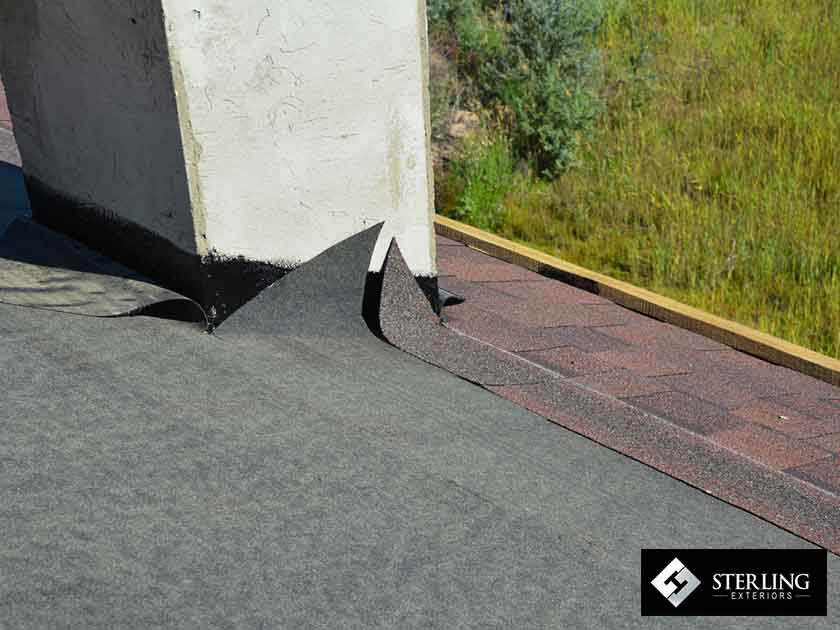The underlayment is one of the most important components of your roofing system. Located above the decking, it adds an extra layer of water protection in the event that moisture penetrates your shingles.

With that in mind, you should invest in a high-quality underlayment to keep the risk of water damage at a minimum. Generally speaking, a thicker and stiffer underlayment material will provide better and longer protection against water infiltration. However, even a high-quality underlayment could run into issues, especially if it was installed by a subpar contractor.
In today’s blog, the leading roof replacement company in the area, Sterling Exteriors, shares some of the causes of underlayment failure. We’ll also discuss why it’s important to have any damage to your roof repaired immediately, along with some fixes you can make to restore your underlayment’s good condition.
Leading Causes of Underlayment Failure
Underlayment failure can happen due to different factors, but low-quality materials and a botched installation by the roofing contractor are the most common causes.
- Poor Material Selection
If your roof underlayment consists of poor-quality materials, it won’t perform its job of keeping water out efficiently. When your roof is constantly exposed to moisture, the material will start to curl and fail prematurely.
Need a new roof underlayment? There are many options to choose from. Manufacturers carry different underlayment materials that are breathable and offer a great degree of protection. This kind of underlayment material won’t buckle when installed. In fact, your roofing shingles will be even more secure since they can lay flatter on it, reducing the likelihood of roof blow-offs and other types of storm damage.
- Poor Material Selection
Note that even a roofing underlayment made with high-quality materials could still fail if it’s installed the wrong way. This is why we emphasize the importance of hiring a skilled and licensed roofing contractor. During the installation process, improper storage or handling can damage the underlayment material. In turn, this will impact the quality, durability and performance of your underlayment straight out of the box.
If you think that your underlayment has been compromised, reach out to a local roofing contractor you trust to conduct a close inspection of your roofing system. You can further improve your roof’s condition and safety by scheduling routine inspections and maintenance to see to it that your roof remains in good condition at all times. Keep in mind that your roofing underlayment can’t be seen from the surface, so it will be difficult to know if there are issues with the material by simply taking a look at your roof.
Risks Associated With Damaged Underlayment
If your roofing contractor has discovered issues with your roofing underlayment, do not hesitate to call them to schedule roof repair services right away. Issues with your underlayment should be addressed immediately. Otherwise, your home could run into serious issues such as:
- Roof Leaks
Damage to your underlayment can progress quickly if you have old roofing shingles. If your shingles aren’t in good condition, precipitation can easily penetrate beneath them, reaching the underlayment. When water continues to accumulate on your underlayment, you can expect severe water damage to your walls and ceilings.
- Mold and Mildew Growth
Having water-damaged underlayment will create the perfect breeding ground for mold and mildew spores to thrive. Remember that mold and mildew can damage your roof and affect your family’s health as well. Severe mold growth can lead to respiratory issues, especially if you have family members that are suffering from allergies, asthma or skin irritations. Make sure that you get rid of mold immediately to prevent the issue from resurfacing.
- Structural Problems
A wet underlayment can put excessive load on your home’s structure, elevating the risk of structural collapse and rot formation. Your underlayment must remain dry at all times to prevent this type of damage.
If you notice these issues during a roof inspection, call on your roofing contractor to have the issues repaired right away. Do not attempt to climb up the roof and repair or inspect it on your own. Without the proper tools and training, you’ll may end up damaging your roof even more, not to mention risking your own safety in the process.
Repairing Underlayment Issues
Spotting a damaged underlayment is next to impossible for the untrained eye. This is why it’s important to work with a professional roofing company to root out the issue and what’s causing it. We cannot overstate the importance of accurately identifying the cause of your underlayment failure. Without properly identifying the root cause, your roofer won’t be able to determine an effective solution. If your area is prone to heavy rain or storms, then you should really have your roofer come over immediately. A professional, detailed inspection of your entire roofing system is critical.
When you’re vetting your prospective contractor, make sure that you check their experience and quality of their workmanship. Ask about previous jobs they’ve completed and contact references about their experience. Last but not least, don’t forget to check their reviews.
Sterling Exteriors is your premier choice for all things roofing. In business for more than 15 years now, we are committed to quality, and it shows in every job we do. Whether you’re looking for a new roof for your home or business, you can count on us for top-notch products and services. To learn more about what we can do for you, simply give us a call at (513) 685-8055 or fill out our contact form. Get a FREE quote today! We serve Cincinnati, Loveland, Newtown and the surrounding OH communities.






